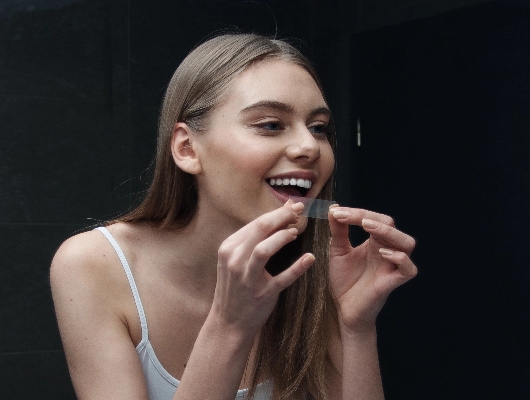SmilefromXwhite
Blog Stories
What exactly is teeth whitening
and how does it work?
- 10.05.2022. SmilefromXwhite
Nowadays, a healthy, beautiful and bright smile is one of the greatest aesthetic features of every person, and teeth whitening has become the most sought after procedure in dentistry. What is teeth whitening, how does it work and which method to choose find out in the latest blog.
Yellow teeth without gloss can send the wrong message. More and more people are trying to beautify their smiles, so teeth whitening has become the most sought after aesthetic procedure in dentistry. Aesthetics and perception of beauty are important issues in modern society that influence social attitudes, interactions and professional advancement. Research shows that the beautiful appearance of teeth directly affects the way people form opinions about another person based on first impressions.


So, what exactly is teeth whitening?
Teeth whitening is a combination of the physical process of removing stains by abrasion (brushing teeth), but also the chemical process of breaking down stains by oxidation.
External stains form on the surface of the tooth, and internal stains form on the enamel and dentin microcracks. To partially remove external stains or stains on the enamel surface, we can use tooth whitening pastes, floss and mouthwashes, but only chemical teeth whitening can remove stubborn external stains and unsightly internal stains that make your teeth look stained.
How does teeth whitening work?
The use of oxidizing agents such as hydrogen peroxide and PAP breaks down the stain components on the teeth located on or just below the tooth enamel. The process takes place in such a way that the bleaching agents enter through the enamel of teeth and and break down large pigmented molecules into smaller, simpler forms, resulting in an overall whiter appearance of the tooth.
What causes staining?
There are several reasons why teeth lose their natural whiteness. Some we cannot control, such as ageing or accidents in youth that can disrupt the development of our tooth enamel. However, the most common stains on teeth are caused by lifestyle habits, ie the consumption of highly colored ingredients of common foods and beverages such as red wine, coca cola, tea, coffee, berries, and also tobacco. Over time, the components of these materials accumulate on the teeth and cause staining. Poor dental hygiene, forgetting about brushing and cleaning teeth, teeth can cause plaque and food stains to accumulate.


Whitening methods and which to choose
Over time, two main methods of teeth whitening crystallized: in-office whitening and whitening at home. Xwhite® professional teeth whitening strips are the only product present in dental offices with standard whitening methods and you can also use it at home.
Xwhite strips will provide the same whitening result as in-office whitening, only the whitening process will take longer due to lower concentrations of hydrogen peroxide, but tooth hypersensitivity does not occur, while in dental offices much stronger gels are used, so the teeth whitening process is shorter and there is an increased risk from tooth hypersensitivity.
Teeth whitening with Xwhite® professional strips does not damage the gums or enamel and the first results are visible after a few days (depending on the treatment you choose). However, the best results will be achieved after using the entire treatment, which lasts 14 days.


Durability of whitening results
Teeth whitening is not definitive. Over time, the color gradually returns to its original state and this is a completely natural process, which cannot be avoided. Tanning depends on the intensity of exposure of enamel to pigmenting agents: coffee, beets, wine, cigarettes, etc. Depending on how much a person is prone to consuming such foods, the need for re-whitening may appear after several months or years.
TIP: for a better whitening effect it would be good to do a professional teeth cleaning in the dental office. (before whitening treatment)
10.05.2022. SmilefromXwhite
Sensitive teeth and what about them?
Have you ever felt pain when consuming a cold drink or hot food? If so, you are not alone. Although pain caused by hot or cold food and / or drink can be a sign of caries, it is also common in people who have sensitive teeth.
- 14.04.2022. SmilefromXwhite

